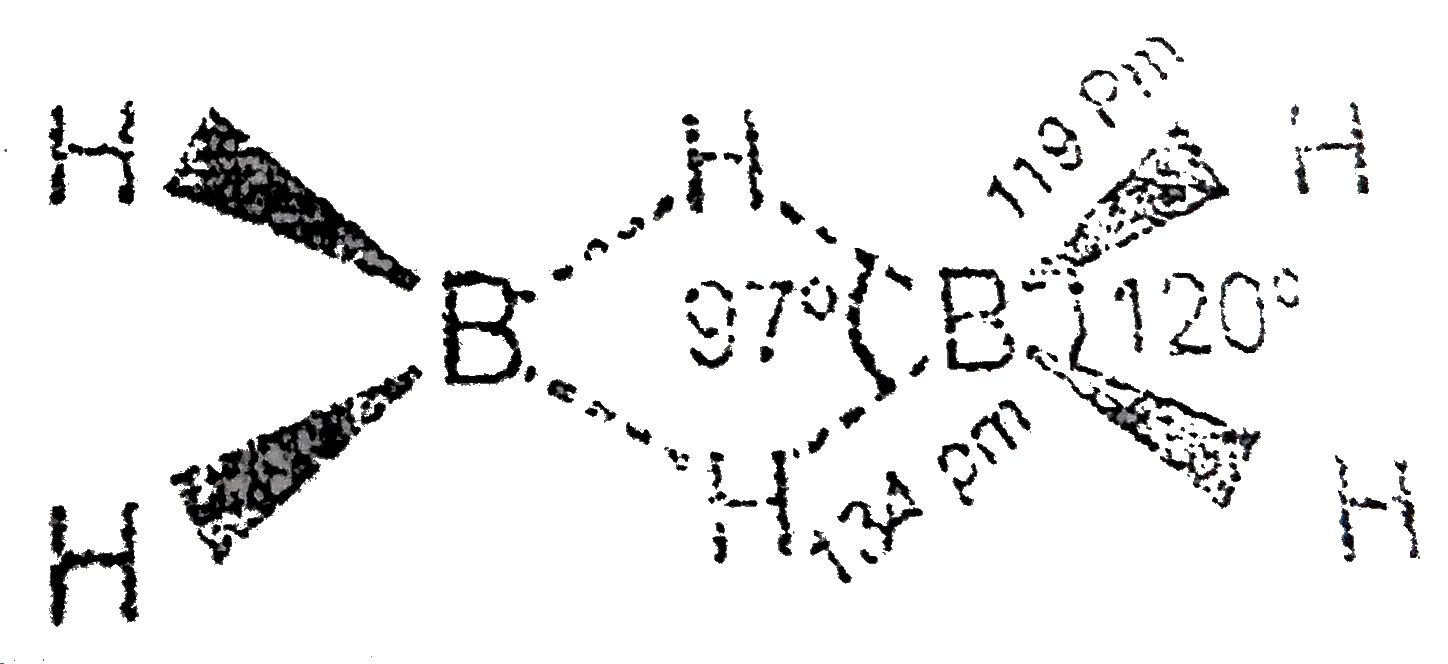Most elements form oxides and hydroxides with different characteristics. Often, regular periodic trends are observed in these oxides and hydroxides. Hydroxides of Na and Mg are distinctly alkaline, while oxides of N and S are distinctly acidic.
Draw the structure of B2H8.

Two centered 3e− bond square
Three centered 2e− bond square
Four centered 2e− bond square
Four centered 4e− bond square
The correct Answer is:B
Topper's Solved these Questions
- P-BLOCK ELEMENT (BORON AND CARBON FAMILY)BOOK - RESONANCECHAPTER - P-BLOCK ELEMENT (BORON AND CARBON FAMILY)EXERCISE - PART - III : OLYMPIAD PROBLEMS (PREVIOUS YEARS) STAGE - V (INTERNATIONAL CHEMISTRY OLYMPIAD (IChO)) Problem 1
1 Videos
- P-BLOCK ELEMENT (BORON AND CARBON FAMILY)BOOK - RESONANCECHAPTER - P-BLOCK ELEMENT (BORON AND CARBON FAMILY)EXERCISE - PART - III : OLYMPIAD PROBLEMS (PREVIOUS YEARS) STAGE - V (INTERNATIONAL CHEMISTRY OLYMPIAD (IChO)) Problem 3
8 Videos
- P-BLOCK ELEMENT (BORON AND CARBON FAMILY)BOOK - RESONANCECHAPTER - P-BLOCK ELEMENT (BORON AND CARBON FAMILY)EXERCISE - PART - III : OLYMPIAD PROBLEMS (PREVIOUS YEARS) STAGE - II (INDIAN NATIONAL CHEMISTRY OLYMPIAD (INCHO)) Problem 1
12 Videos
- P BLOCK ELEMENTSBOOK - RESONANCECHAPTER - P BLOCK ELEMENTSEXERCISE - PART -II
24 Videos
- P-BLOCK ELEMENTS (HALOGEN & NOBLE GASES)BOOK - RESONANCECHAPTER - P-BLOCK ELEMENTS (HALOGEN & NOBLE GASES)EXERCISE - APSP PART-3
22 Videos
Similar Questions
Most elements form oxides and hydroxides with different characteristics. Often, regular periodic trends are observed in these oxides and hydroxides. Hydroxides of Na and Mg are distinctly alkaline, while oxides of N and S are distinctly acidic.
Draw the structure of sulfur dioxide
View SolutionMost elements form oxides and hydroxides with different characteristics. Often, regular periodic trends are observed in these oxides and hydroxides. Hydroxides of Na and Mg are distinctly alkaline, while oxides of N and S are distinctly acidic.
Draw the structures of the possible arachano-boranes derived from X.
View Solution
Knowledge Check
An element of group 2 forms covalent oxide, which is amphoteric ini nature and dissolves in water to give an amphoteric hydroxide. Identify the element.
ABerylliumBMagnesiumCCalciumDBarium
Most elements form oxides and hydroxides with different characteristics. Often, regular periodic trends are observed in these oxides and hydroxides. Hydroxides of Na and Mg are distinctly alkaline, while oxides of N and S are distinctly acidic.
Draw the structures of all possible isomers of Z (show only boron-carbon framework).
View SolutionMost elements form oxides and hydroxides with different characteristics. Often, regular periodic trends are observed in these oxides and hydroxides. Hydroxides of Na and Mg are distinctly alkaline, while oxides of N and S are distinctly acidic.
Write the general formula of arachano-boranes.
View SolutionMost elements form oxides and hydroxides with different characteristics. Often, regular periodic trends are observed in these oxides and hydroxides. Hydroxides of Na and Mg are distinctly alkaline, while oxides of N and S are distinctly acidic.
Write the general formula of arachano-boranes.
View SolutionMost elements form oxides and hydroxides with different characteristics. Often, regular periodic trends are observed in these oxides and hydroxides. Hydroxides of Na and Mg are distinctly alkaline, while oxides of N and S are distinctly acidic.
Write the molecular formula of a carorane (Z) obtained by replacing two Boron by carbon atoms in closo-dodecaborane anions.
View SolutionMost elements form oxides and hydroxides with different characteristics. Often, regular periodic trends are observed in these oxides and hydroxides. Hydroxides of Na and Mg are distinctly alkaline, while oxides of N and S are distinctly acidic.
Diborane reacts violently with water and releases hydrogen. Write a balanced equation of this reaction.
View SolutionDiscuss the important characteristics of oxides, hydroxides, and carbonates of group 2 elements.
View SolutionState the general trend in periodicity in properties of oxides, hydroxides, oxy-acids and hydrides of compounds of elements across a period and down a group.
View Solution
